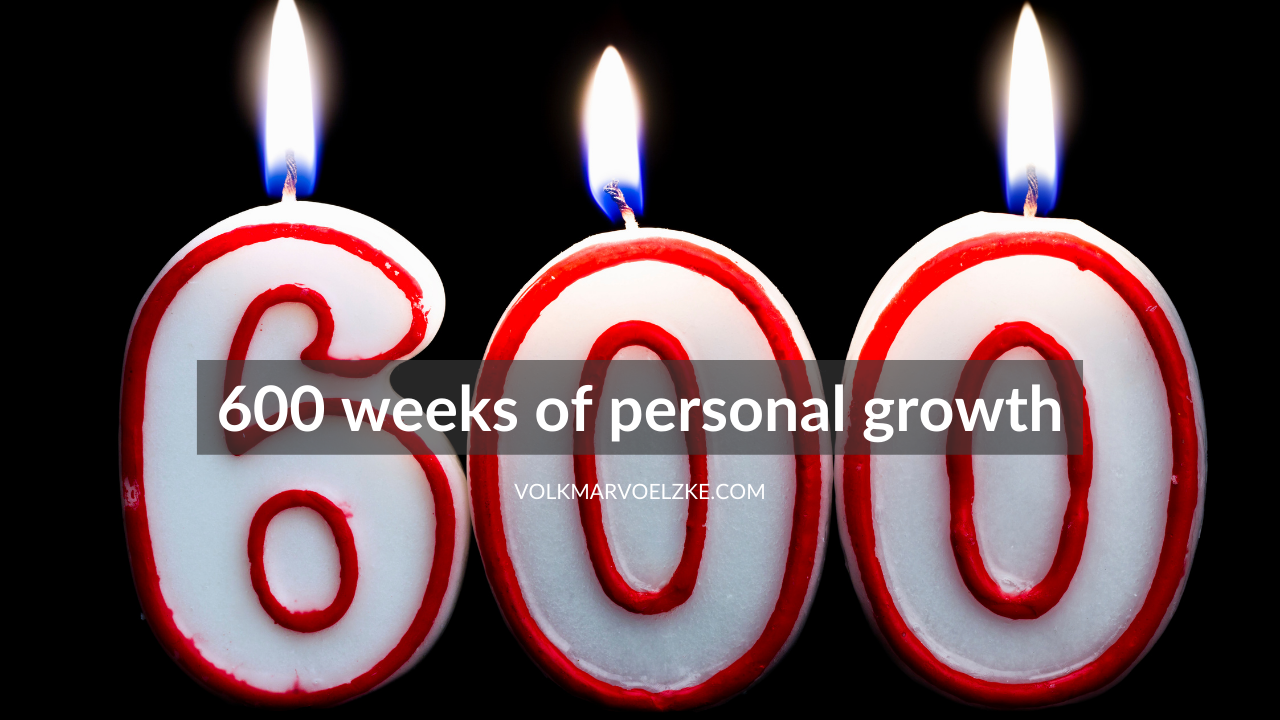📈 Your Corporate Growth Mindset

The most successful businesses have a growth mindset. All of them. No exceptions. What is more, they have a mindset of passion and enthusiasm, most of the time also a mindset of happiness.
There is not one long-term successful and competitive organisation on earth that has a fixed mindset, grumpy people, no spirit, and unhappy customers. Not one!
So, why do then so many companies run with high complacency (“we don’t want to change!”), lacking enthusiasm, and surely missing happiness? Look around in your business: as long as you do not belong to the top one percent of outstanding organisations, you’ll find signs of mediocrity all around you.
The key challenge for most is that a growth mindset requires your own readiness to grow, each day, each hour, and each minute. To learn and improve. To listen and adjust. My key question is always this: How many hours do your team members (and yourself) spend learning each week? If the answer is less than 4 hours per person, you have an issue!...
👎 The 3 Greatest Reasons For Underperformance

Over the years of my coaching and consulting practice, I’ve been confronted with a number of repeating practices in all kinds of organisations that result in performance levels far below their potential.
In other words: many people, teams, and entire organisations are constantly sabotaging themselves because of their thought patterns, routines, and behaviours, consistently staying below their possible performance levels.
Here are my top 3 reasons for underperformance. Look at your own team and assess how much better you are. If you’re not, start changing today.
- No clear vision. Yes, I have stated this over and over again. And still, most businesses lack a compelling vision for their future. The results on team motivation are tremendous. How well can you perform when you don’t know in which direction you are heading?
- No consistent strategy execution. Most organisations do not have a clear, simple, and transparent strategy execution with milestones, measures of success, and resp ...
🏁 How to ensure the implementation of strategies

Do you always fully implement your business strategies? My experience shows: hardly anyone manages to do that.
And I'm not talking about deliberately interrupting the implementation because important parameters have shifted.
No, I'm talking about the fact that you and the leadership team really want to implement the strategy, but it's still not progressing properly.
This does not only waste valuable resources. No, you also lose time and, most importantly, it frustrates people.
There are various companies where the lack of strategy implementation has already become a habit. "This too shall pass" is a typical statement from the people who are supposed to be driving the implementation.
Why is this so difficult? Why do important strategic decisions too often fall by the wayside and opportunities go unused?
Here are the three most important levers you need to operate, from my experience, if you want to implement your strategies and reap full benefits:
- Involve people. The mistake is ...
What makes a strong business strategy

There are so many myths and methods surrounding the topic of "strategy" that it is a real challenge for any CEO or division head to keep track of the essentials.
If I ask three CEOs what they want to achieve with a strategy - in other words, why they need one - I get at least four different answers. In other words, it's often not clear what makes a good strategy in the first place.
The result: countless folders and file servers full of presentations and documents that all contain some kind of detail, but often do not add up to a consistent whole.
If you then try to roll out such a "strategy", it usually gets stuck at the first contact with the team - i.e. those who have to drive the implementation for the most part.
From my experience, there are three important characteristics that distinguish a strong strategy from a mediocre or useless one:
- Ambition. I always say, "If you want to improve just a little, you don't need a strategy, you need a plan." One doesn't have much to do wi ...
Why you need a vision

There are insights in leadership and success science that are not devalued by the fact that they are sometimes overused. On the contrary, these levers of success remain true and effective, no matter how often they are applied.
"Empowerment" is one of them, as is "vision." Today, we're talking about the latter. Vision is your clear picture of the ideal future you want to create.
The longer I coach top leaders and support teams on their path to top performance, the more I see the importance of a clear vision. Often, however, it is completely missing or designed in a way that defeats its purpose.
Here are the top three reasons why you always need a strong vision:
- Focus of Energy. A large part of outstanding success comes from using your energy - and that of your team - in the most focused way possible. But that focus can only be established if you know exactly where you want to go. Without a clear vision, energy is directed at too many different issues and gets wasted.
- Clarity abo...
600 weeks of personal growth

Every week I send out an issue of the Friday Noon Memo to ambitious people - and I've been doing it for 600 weeks!
That's an impressive number. And it confirms one of my principles for success: Consistency and follow-through are an essential foundation for success.
Here are three of the memos from the past years. Enjoy reading, watching and applying!
 Is your company exciting or perfect?
Is your company exciting or perfect?
One of the thought models I use with leadership teams is the typical business development curve between the two dimensions “Enthusiasm” and “Perfection”. The typical life cycle of any business starts out with high enthusiasm and high imperfection of anything they do. ➔ Read more
 Among friends
Among friends
Do you feel like being among friends at work? Otherwise success potentials will be neglected! ➔ Read more
 The amazing differences
The amazing differences
Most people never look beyond their own beliefs and experiences. Here are three ideas about what you can do for you and your team to counter the danger of mental inbr...
Do you use your acceleration lane?

Do you also get upset about drivers who do not accelerate on the acceleration lane of the highway? It happens from time to time and it is irritating and even dangerous.
Well, the same behavior is exhibited by many leaders when it comes to acceleration in business. By this I mean, of course, picking up full speed at the beginning of the year, but also accelerating strongly when implementing any strategies, launching initiatives, personal development and so on.
From my experience, generating high momentum quickly is one of the most important success factors in life as well as in business.
As success guru Tony Robbins so beautifully puts it, "Make a clear decision, establish the powerful why, and then take MASSIVE action immediately!"
Here are three key barriers that often keep us from accelerating:
- Contentment. After all, I keep emphasizing that high satisfaction is not a good condition for outstanding success. Contentment makes you sluggish. Everyone knows this about themselves. ...
How to gain momentum quickly in 2021

The beginning of a new year is an artificially defined milestone we love to take as a trigger for a new start. Energy flows where the focus goes, and in this sense, it is good to have a focus on making this New Year a successful one.
However, much of the energy and many of our hopes and plans of the early days of the year quickly vanish.
The root cause is that success comes from repetition, perseverance and courage, not from a fierce, yet short fire.
So the question is: what can we do to kickstart the New Year in a way that makes it a lasting success, in your business and for yourself? Here are 3 answers:
- Define the ONE big goal you MUST achieve within 12 months, both for business and your private life. Be ambitious and specific. Maybe you want to triple your revenue. Or sell your company. Or get married (again). Or relocate to the country of your dreams. Write these goals down.
- Define three areas you need to change substantially to achieve this big goal. If you don’t need to ...
Your Compass For 2021

Have you arrived well in the new year? I hope so!
And what do you do at the beginning of a new year? That's right: you take on a lot of things, of which you only implement a little later. That's not what we want to do here - namely, by focusing on foundations instead of actions.
Here's my suggestion to help you make 2021 an incredibly successful year for your family, your team, your customers and you:
- Establish guiding stars. By this I don't mean simply "goals," but your emotional anchor point in the future. I recommend that everyone define a guiding star for the next 12-36 months. What do you long for, in your personal life and in business? What would make you absolutely happy? The guiding star can consist of several different themes. The important thing is that it is emotionally charged. And that it is ambitious. So, go ahead: write and draw!
- Determine new ways of thinking. How do you need to think differently to get closer to the guiding star? Yes, that's right: You have to qu ...
Almost over!

Now, there are only a few days left until the turn of the year. As you get older, you're almost inclined to think "again?" Wasn't the last one just recently?
And what do you do before the turn of the year? That's right: you reflect on the past 12 months. I'd like to do that briefly here, too, by pointing out three of my blog posts that, from my perspective (and from the perspective of my readers), got to the heart of things particularly well.
So here are my three favorites to reread and ponder:
 The amazing differences
The amazing differences
Most people never look beyond their own beliefs and experiences. Here are three ideas about what you can do for you and your team to counter the danger of mental inbreeding. ➔ Read more
 Emotion Eats Logic for Breakfast
Emotion Eats Logic for Breakfast
We make all decisions one hundred percent emotionally. You can use the underlying mechanisms in a positive way for your business and leadership at any time if you want to get people to act. ➔ Read more
 How courageous are you?
How courageous are you?
Coura...
